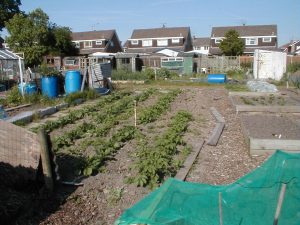The traditional method of growing potatoes, which has worked well for me, requires the soil to be dug over and manured in the winter. In the spring, cultivate the entire patch removing any weeds.
Mark out your rows, spacing according to the variety being grown. The first and second early varieties need the rows spacing 60cm (2 feet) apart and maincrop varieties spaced at 75cm (30 inches) between rows. Some vigorous varieties may need a little wider spacing still.
Draw a trench about 10cm (4″) deep along the rows. Usually you would use a draw hoe to make the trench or scrape along with the corner of a spade blade.
Apply a 2.5cm (1″) layer of compost or well-rotted manure or lay wilted comfrey leaves in the bottom of the trench. Or you can scatter some potato fertiliser along the trench, roughly working it into the soil.
Alternatively you can just make a hole at each planting position with a trowel. I’ve seen it done with a bulb planter as well. The fertiliser / manure etc is just placed around the hole.
Place both first and second early seed potatoes 30cm (1 foot) apart but the maincrop types need a little more space, 40cm or 15″ for them.
Next draw soil from the middle of between the rows over the potatoes. You should end up with ridges above the potatoes clearly marking where they are.
Earthing Up Potatoes
After a few weeks, the leaves will start to appear out of the soil. Once these are a 15cm (6″) or so high, draw more soil from between the rows up to and on the ridge. This should bury about half of the foliage. You can repeat the process once or twice more as things progress.
This process is called ‘earthing up’ and serves three purposes:
- First it protects the foliage from late frosts that will check the growth of your crop.
- Second it increases the eventual yield as the potato reacts to being buried like this by producing more tubers.
- Third we want to prevent light from reaching the new tubers by keeping them covered with soil.
The potato tuber (the actual part we eat) has a tendency to grow near to the surface and sunlight causes the tuber to go green and produce a chemical called solanine to deter pests.
This is mildly poisonous to us, in large doses it can cause headaches and stomach problems. Don’t forget potatoes are actually in the same plant family as deadly nightshade. Incidentally, if you do have some potatoes with green areas on them at harvest, keeping them in absolute darkness for a few weeks usually reverses the process.
All this earthing up does take time and if you happen to be away when it needs doing you can find it difficult to get between the rows when the haulm has grown. It’s often said that growing potatoes is good for clearing the soil. The fact is that it is the cultivation required to grow potatoes that clears the soil for you, killing any weeds in the process.
In dry spells water between the rows into the trench created by earthing up. This is more effective than sprinkling the whole crop as wetting the haulm in warm, humid periods can encourage blight.
The difference between a crop and a good crop is down to preventing competition with weeds, adequate nutrients and plenty of water in dry periods.
There are other methods you can use to grow your potatoes that achieve the same end and possibly with less work – see below.
Potato Growing Articles
- Growing Potatoes Overview – How to Grow Potatoes Guide
- How Many Seed Potatoes are Needed
- Potato Flowers, Fruits, Seeds & Breeding
- Growing Potatoes – Standard Traditional Method
- Growing Potatoes Under Straw Mulch
- Growing Potatoes Under Black Plastic (Polythene) Sheet
- Potato Growing in Raised Beds & Ridge Planting Potatoes
- Growing Potatoes in a Barrel – Patio Growing Potatoes
- Growing Potatoes in Bags | Greenhouse Potatoes
- Second Crop Autumn Planted Christmas New Potatoes
- Can you chit supermarket potatoes?
- Potato Varieties for Flavour -Boiled Baked Roasted Mashed
- Potato Fertiliser Program Program & (NPK) Requirements
- Potato Blight Cause, Identification. Prevention, Treatment Potato Blight
- Wireworm in Potatoes Cause Identification Prevention Control Potato Wireworm
- Eelworm Potato Cyst Nematode – Control Potato Eelworm
- Dry Rot in Potatoes Cause Identification Prevention Control of Potato Dry Rot
- Potato Scab – Common Scab in Potatoes
- Potato Scab – Powdery Scab in Potatoes
- Hollow Heart, Splitting & Spraing Potatoes
- White Spots on Potatoes Lenticels & Potato Stem Rot
See Also:
- Growing Potatoes for Show, Introduction & Best Varieties
- Growing Potatoes for Show, Cultivation of Show Potatoes
- Growing Potatoes for Show Harvest & Showing Potatoes




